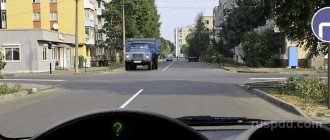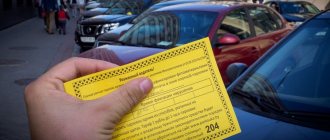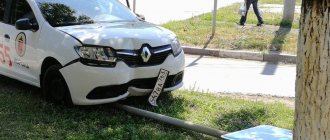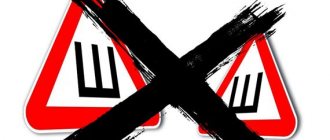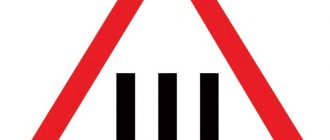Days of the week signs
The last three signs that will be discussed today indicate specific days of the week when the road sign installed above them is in effect:
– Saturdays, Sundays and holidays. In simple terms, this sign can be called “non-working days”. Those. it operates only when the population working a 5-day work week rests.
- work days. The sign is the opposite of the previous sign.
- days of the week. The sign indicates specific days of the week when drivers must heed the sign posted above it.
A similar combination was installed near one of the markets in the city of Ryazan, where pedestrians may appear on the roadway on weekends. However, on weekdays on this section of the road you can drive at a speed of 60 km/h.
The next article in the series will look at a few more additional information signs .
from RUB 1,146.56
see also
Comments 109
I support the author: “share information with others - don’t let these freaks make money.”
For simplicity, let's not consider “hammers”. Let’s just note that not only in Moscow (I won’t say for the whole of Russia) but also in some large cities of the Moscow Region, dedicated lanes marked with sign 5.14 were also equipped with a “brick” 3.1 hanging above this lane, with a “down arrow” sign. This created confusion among taxi drivers: are we allowed or not? Those who dared to check received a 500 ruble fine from the cameras for each case. TsAFAP inspectors explained that, by virtue of 3.1, these lanes are only suitable for route public transport, i.e. buses and trolleybuses, but taxis are not allowed, because although they are public, they are not route buses. Yes, that's right, not a route one. What do you think, if 3.1 hung without 5.14, what would that mean? This would mean exactly this: only route vehicles are allowed to move. But 3.1+5.14 is nonsense, two contradictory signs, and the traffic rules do not provide for this. Only the contradiction between a temporary sign and a permanent one is provided for—here priority goes to the temporary. The unfortunate combination 3.1 + 5.14, when both signs are constant: one allows the movement of someone else (in particular, taxis), except for trolleybuses, and the other prohibits it - this is stupidity and misleading the driver. Driving a taxi on a dedicated lane in this situation does not constitute an offense! Find in the traffic rules the text that the brick is most important. It's not there. I urge all taxi drivers who have suffered from this nonsense to complain to the Moscow prosecutor’s office about the actions of the Data Center and TsAFAP, to demand the cancellation of all decisions received, and the return of fines paid, if they have already been paid.
Read also: KAMAZ coolant temperature sensor
Is there a flaw in my arguments? Be that as it may, from the end of December 2015, the data processing center began removing bricks from all allocated areas in Moscow, and from January 2021 they were gone. Even electronic billboards appeared: “All legal taxis can move on all designated lanes in Moscow.”
Well, to hell with them and their allocated funds... I didn’t go anywhere and I don’t go... because I’m tired of replenishing the budget. On Leningradskaya in one place they hung some signs regarding the allocated area, and after 200 meters there are others hanging...
As for foreigners, I don’t see any problems. I was going to Finland by car, reading notes about their rules. They also have signs with the days of the week. Learned it. If I didn’t learn it, I wrote it down. If you don’t write it down, you’ll be fined once, then you’ll learn it right away. And with these dedicated cameras, I try to never go into them, just in case, otherwise the date or time on the camera will go wrong and then go prove that the shadow from the car is from the sun on the Sun, and not from the full moon on Mon. Well, if I have to stop by, I always make sure that the hammers are hanging.
Until now, speaking about additional information signs (or plates), we have noted the restrictions or additions they introduce, which relate to the distance, direction of action or type of vehicle.
In other words, the signs installed with these plates were effective on a certain section of the road, which was characterized by these three signs.
However, the Rules provide for a large group of signs that limit the effect of the signs installed with them according to a different criterion - time.
It is not at all difficult to guess that these signs indicate a certain period of time - either certain days of the week, or some chronological period. And a sign installed with one of these signs will only be valid for the specified period of time.
Read also: Kia ceed lamp bases
Let's look at the first sign - with a “red snowflake”. It is called "Saturdays, Sundays and holidays" (8.5.1). A “Red Snowflake” sign installed with any sign means that this sign will “work” only on weekends (Saturday, Sunday) and holidays. And never again.
Judging by the image, entry to this section of the road will be prohibited only on Saturdays, Sundays or public holidays (i.e. holidays prescribed in the Labor Code of the Russian Federation). On other days of the week (of which, by the way, there are much more), the ban on entry to the specified section of the road from this direction does not apply.
Or here's another example.
The combination of the sign we are interested in and the “Parking (parking space)” sign (6.4) means that parking on this section of the road will be allowed only on weekends and holidays. On weekdays, parking here is not allowed.
Thus, sign 8.5.1 “Saturdays, Sundays and holidays” (“red snowflake”) informs drivers that the effect of the sign installed with it will only apply to a specific period of time - on non-working days of the week.
If this information was useful to you, please write about it in the comments. If you have any questions, write, I will definitely try to help you.
What does the “Snowflake” sign in a triangle mean?
The image of a snowflake in a triangle is not the most common road sign, but it can still be observed from time to time. That is why it is useful to consider what information this sign carries.
This sign is a warning sign and communicates something to road users.
Such different snowflakes
Please note that snowflakes on the road can be different:
- with red border on a white background;
- in a yellow triangle with a red border;
- there is a blue snowflake in a white triangle with a red border;
- snowflake or star in a rectangular white sign.
Of course, considering snowflakes in a rectangular sign does not apply to this material, but we will still answer that this option indicates that work is carried out only on weekends and holidays.
That is, if you see such signs, then they indicate that the signs above will only be valid on weekends and holidays.
Snowflake in triangles
It should be noted that these are warning signs. As you might guess, a snowflake, in turn, indicates some weather features, in particular the presence of ice and similar factors.
Thus, if you see a snowflake sign in a triangle on the road, you should be careful; further on there may be a slippery section of the road, or the sign warns of an abundance of snow.
Also, other signs with snowflakes in a triangle indicate that the road is snowy or, so to speak, winter. Therefore, caution should be exercised and monitored for possible disturbances that may occur on such roads.
Signs on the dashboard
In addition to the road signs themselves, it is also advisable to consider signs with snowflakes in a triangle, which can sometimes appear on the dashboards of various cars.
There this sign is quite often visible in winter. Snowflake operates in a strictly defined temperature range, usually just above zero.
This temperature is the most likely for ice to form on the road. Therefore, snowflakes in triangles on car dashboards indicate, firstly, the need to change tires if the motorist has not already done so, as well as possible icing of the road.
When the temperature rises above the specified range or falls below zero, this icon disappears.
Note. On some car models, the snowflake on the dashboard may light up in different colors, thereby indicating a different likelihood of ice.
Summary
Thus, both on the dashboard and on the road sign, a snowflake in a triangle indicates the need to be vigilant and careful.
In any case, we are talking about a winter road, on which you should act more measuredly and scrupulously.
In addition, these signs indicate that you need to change tires in a timely manner, since driving on non-seasonal tires on ice and snowy roads is, to put it mildly, impractical.
( 2 ratings, average 5 out of 5 )
dixnews.ru

